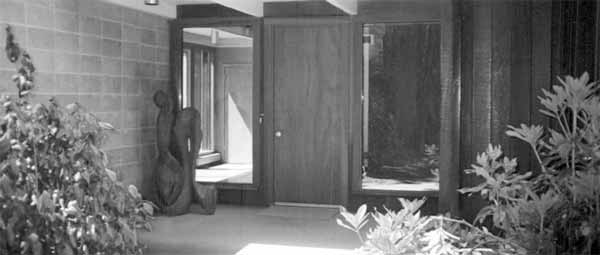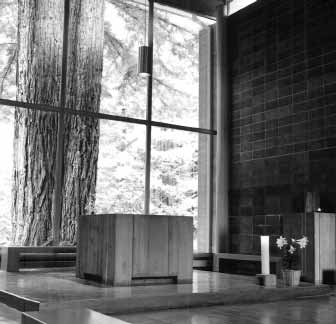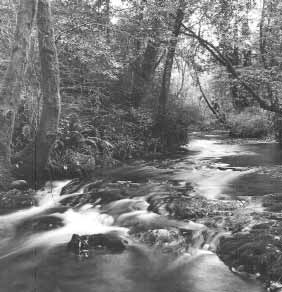
Looking over Whitethorn Valley towards King’s Peak. Photo
courtesy of Sanctuary Forest.

Door to
the Refectory. Photo by Annette Holland.
REDWOODS MONASTERY AND THE FOREST
by
Annette Boushey Holland
Through
an odd twist of fate—or a miracle—Redwoods Monastery
was established in the heart of California’s Lost Coast
right before an era in which the watershed of the Mattole
River could have been altered beyond recognition, either through
construction of a dam or through logging of the old growth
forests. The story was told to me by some of the sisters who
left Belgium for California in 1962. When their Cistercian
order decided to branch out and found a new monastery in the
early 1960s, the sisters at first expected they would be settling
in Africa, in what was then the Congo. But the political situation
there was too unstable, and the plan was canceled. Instead,
in 1962, the Catholic Church was offered a piece of land in
the Whitethorn Valley for use as a monastery, and the sisters
decided to relocate there. Since then, the presence of this
contemplative community has had a profound influence on the
unfolding history of the Mattole River watershed, especially
on the movement to protect its ancient forest.
The story of the monastery’s establishment
begins in 1939, when a man named Bob Usher arrived in the
Whitethorn Valley. Usher was well known in Hollywood as a
set designer and artistic director, and his work was honored
by three Academy Award nominations. He arrived at the Mattole
River, where the Barnum family owned a large piece of property,
just as a logger was beginning to cut one of the giant redwoods.
He stopped the logger, saying that he would buy the land,
which he did.
Bob Usher lived on the land for two decades and built a house
using only fallen trees. Then one day, when he was in a place
called the Grove, down by the river, he had an experience
that people in the Church refer to as a “locution,”
which is like a vision except that one hears a voice. The
voice that Bob Usher heard told him that the land belonged
to God, and that he should give it to the Church. So he donated
his land to the Catholic Church for use as a monastery, and
eventually went to live in a men’s monastery called New
Clairveaux, in Vina, California.
Around the same time that Bob Usher had his locution, the
sisters from the Cistercian Monastery in Belgium had just
been informed that their plan to move to the Belgian Congo
could not proceed. They were then told of Bob Usher’s
gift of land, and the Abbess, Sister Myriam, was offered a
chance to visit it. At first, Sister Myriam was concerned
about how remote the property was, but when she arrived she
saw right away, as she says, that “The land was full
of energy, mystery, beauty . . . and the trees in the grove
were like a cathedral.” She spent eight days there, and
fell in love with the land.
 |
|
The
altar inside the Chapel. Photo courtesy of Redwoods
Monastery
|
Sister Myriam’s decision to start a new
monastery in northern California was in a sense a choice for
a new embodiment of an ancient way of life dedicated to union
between the human and the divine. Within the monastic cloister
and within their silence, manual work, and prayer, the sisters
strive for awareness of God’s presence. They seek the
divine presence both within and around them, and some believe
that the particular place in which this monastery is built
is especially conducive to religious experience.
Madeline McMurray, a religious studies teacher at Humboldt
State University, has been a frequent visitor to Redwoods
Monastery for many years, and she finds the location to be
“a place of amazing beauty.” She also says that
she appreciates what the sisters have taught her about the
Christian idea of incarnation. “Sometimes we have Christian
ideals that are so spiritualized,” she says. “And
when you go to the monastery you are reminded that it is in
the specifics—that the spiritual life is in the specifics
of how you do your work, how you tend the garden. And then
as you are aware of God or Spirit coming into matter, into
the material world, the land really becomes sacred.”
For the sisters who first came to the Lost Coast, however,
the connection with the land and the transition to this new
place was not easy. In fact, setting about the construction
of a new life in this near wilderness was a nearly overwhelming
experience. They traveled in traditional black-and-white habits,
leaving an orderly schedule and ample silence for the challenge
of living in a plywood cabin, planning for a new church and
new buildings, and learning to speak a new language.
Finding themselves in the middle of the old-growth forest
was also astonishing. Sister Godelieve, like Myriam, responded
immediately to the beauty of the forest. She says that when
she arrived, her first impression of the forest was to be
“dumbfounded by the majesty of the trees . . . I couldn’t
believe the grandeur. When we arrived, there was a footbridge
over the Mattole, and the others were waiting for us in the
Grove, and when we stepped out, they looked like little dwarfs
to me, compared to the trees.”
Sister Godelieve’s initial appreciation for the forest
has deepened through the years of contemplative life in its
presence. She says that for her the trees have become “an
image of going to God . . . They are so straight, it’s
like the movement of the soul, upwards.”
For Sister Veronique, the early days were not easy. After
the openness of the flat land and gently rolling hills of
Belgium, she felt “closed in” by the redwood forest.
To her the trees were beautiful, “but they offered no
view.” Everyone else was so enthused about the big redwoods,
Veronique recalls, “but my impressions were a little
different than the others, and I learned very quickly that
madrone was my favorite tree, not the redwood.” As time
has passed, though, Veronique has found the monastery’s
location to be helpful to her contemplative practice. She
describes monastic life as “a pathway toward God,”
and says that while the path does not exclude humanity, for
her it is in silence that the experience is most profound,
and she finds the quiet of the natural world immensely helpful.
“If I go to the second meadow,” she says, “and
it is real still, and I am in tune to that, I have to pray.
I have to bow, and I have to see God. Because that’s
when I feel the presence. And I can see it as much in nature
as I can feel it in the church at meditation.”
Sister Myriam’s love for the forest also deepened as
she lived there, and her dedication to the trees was of enormous
importance to the early efforts of the surrounding community
to organize for the protection of the watershed. Yet even
today, she finds it difficult to talk about her relationship
to the redwoods. “They speak through their silence,”
she says. “They’re hospitable to life—insects
to birds—to tears, to joy, to people. You can lean against
them when life becomes too much. They speak, of stability—which
our planet needs so badly right now. They make a plea for
help, for protection.” It is Sister Myriam’s belief
that “the members of this community are the guardians
of the forest. But so is the forest the guardian of our souls.”
Their guardianship of the forest led the sisters of Redwoods
Monastery into a collaborative effort, working with citizens
of the Mattole River watershed, in which they played a crucial
role. Rondal Snodgrass, who is now executive director of a
local land trust known as Sanctuary Forest, was one of the
early organizers of the effort and has been active all along.
He says that if Redwoods Monastery had not been established
in the Mattole watershed, the area “would be a lake for
public recreation, like Lake Mendocino, or it would be one
strip of clearcuts on both sides of the Whitethorn Road, like
the hills around Scotia.”
Before the forest became an issue, the local citizens and
women of the monastery received a lesson in what Myriam calls
“gently confronting the authorities.” In the early
1970s, the Bureau of Reclamation announced a shocking plan
to build a dam on the Mattole, between Four Corners and the
Junction, which would have put the monastery under water.
Local residents opposed to the project formed a committee,
and they began meeting. Sister Diane, who joined the monastery
in 1964, served as its second abbess, and now lives away,
but she remembers how five of them went to a public hearing,
held in Honeydew, “clear over the mountain,” in
the back of the chaplain’s truck. “It was a great
event,” Diane says, “because the ending was wonderful.”
She remembers how Veronique stood up, as one of the last speakers,
and said slowly, in her Flemish accent, “All I can do
is ask for mercy. We’ve come here to found this monastery,
and if I understand you well, your dam would inundate the
monastery property. We want to live here. So, what can I do,
but say ‘have mercy’?”
The plan for the dam was eventually dropped, and the monastery
was allowed to continue its work. The nature of the monastery’s
work is often not well understood. Sister Godelieve says that
their calling—a little different than the ministries
of teaching or nursing—is another way to dedicate their
lives to the service of God. “It’s a different type
of journey,” she tells me. “It’s a balance,
according to the Rule of Benedict, and there is common prayer,
individual prayer, lectio divinia or scripture reading, study
and manual labor.” There is a great emphasis on manual
labor in the Cistercian tradition, she explains, on doing
simple work and living from the labor of your own hands.
Sister Kathy, who currently serves as mother superior for
Redwoods Monastery, believes that part of the purpose of monasteries
is to provide a place where those devoted to the contemplative
life may “leave the world.” As she explains it,
“You go apart to live a life totally dedicated to God.
Typically monasteries have been on the margins of society
and culture, rather than just right in the mainstream. The
purpose of that distance is to see—to get a vision, to
get perspective, to hear what’s happening—and monasticism
traditionally has had a prophetic role to offer society.”
|
|
|
Madonna
and child, on the chapel wall.
Photo by Rondal Snodgrass.
|
Redwoods Monastery is part of the Cistercian
Order, which began at Citeaux, in France, in 1098. The members
of this community are carrying on a traditional way of life
that follows a set of rules written down by Saint Benedict
shortly after the year 500. The founders of the Cistercian
order had, by the time of their own turn of the millennium,
grown disillusioned by the affluent lifestyle most Benedictine
monasteries had adopted, and they wished to return to a simpler
life of contemplation, to what they saw as the essence of
the monastic tradition. They went off into what was then a
vast forest to start the new order, and Cistercian tradition
ever since has called for monasteries to be surrounded by
nature. Citeaux, however, has in the last nine hundred years
been surrounded by civilization, as have most of the other
monasteries in Europe. Sister Kathy says that she feels privileged
to have been called to live in such a magnificent place, and
she also feels privileged to be part of an order carrying
on a tradition that is as old as some of the massive trees
that surround their enclosure.
The women of this monastery do not simply carry on the forms
and rituals of an ancient tradition. Their community is filled
with life and vitality, and they are innovators, having not
only brought this Cistercian way of life to California in
the early 1960s, but also having adapted and shaped it in
response to the natural and human communities in which they
found themselves.
Sister Myriam sees that monasteries today fill a different
role from their predecessors in the Middle Ages, but there
is a sameness as well. “A monastery is a monastery, and
people come because it is founded upon communication with
the divine, reception of the divine, on living in a way that
says there is a spiritual dimension to our lives and to nature.”
In the past, Myriam says, there was more emphasis on fuga
mundi—the flight from the world. “But to me, a monastery
is part of the world. It’s a dimension of the world.”
Everyone I speak to has grappled with the issue of how much
the monastery needs to maintain separation from the world,
and how much benefit can result from interaction with the
world. When I ask Sister Kathy about this, she quotes Thomas
Merton, the famous writer and theologian who was also a Cistercian
monk, and who spent time at Redwoods Monastery. She tells
me, “Merton says something like, ‘We leave the world
only to discover that we are the world, that we carry the
world within us.’ So, how do we contribute to the cry
of humanity, to the cry of the environment? We contribute
through prayer, first of all. We contribute through how we
live our lives, our daily life. Monastic life is a gospel
way of life, which means a way of love—love towards self,
towards God, towards all people and creation. It’s not
ethereal; it’s an incarnational reality, and we have
to embody it; we have to live it. Obviously we fail, like
everyone else. We fall down. But then we pick ourselves up
and we grow. It’s a very concrete way of living.”
When Rondal Snodgrass describes the impact that the women
of the monastery have had on his attitudes and work, he says,
“What they’ve taught me, which has been a big influence
on my role in Sanctuary Forest, is to not deny adversity,
not to separate from adversity, but to try to merge, to engage
with adversity, making it part of the whole experience. And
in the same way, they’ve taught me how you don’t
want to even get to the point where you could burn bridges.”
They have always encouraged the environmental community to
take an honest look at itself and “to include the adversary
as part of yourself, not to exclude, not to demonize the opposite
position in the dialogue.”
David McMurray, who has been on the board of directors of
Sanctuary Forest since the early days, also sees the women
of the monastery as helping to remind everyone of the value
of the rotting tree, the value of the life process. “Always,
when we as a group get bound up in the practicalities of details—like
purchasing something when we had no money—they would
take us back to the forest’s needs, the needs of the
salmon. They would be the reminders of the necessity of looking
at the fullness of life.”
Back in 1986, when red flags first appeared on trees in the
forests of the Whitethorn Valley, a neighbor gathered them
and brought them to the monastery asking what they meant.
Sister Myriam started making phone calls, and soon a group
of about a dozen people from the local community began to
organize. They discovered that Collins Pine Company, based
in Oregon, had completed a timber cruise to prepare for selling
the six parcels they owned in the area, including 1,200 acres
of old-growth redwood and fir. The group, which soon took
the name of Sanctuary Forest, held meetings in the monastery’s
guest dining room. There was no easy way for this initial
group to protect the trees. Their first fundraising event
was to offer $100 each and gather to hold hands around Big
Red, a two-thousand-year-old tree in the heart of the forest.
Their strategy was agreed upon in response to Sister Myriam’s
expressing her belief, during one of the first meetings, of
the importance of respecting and honoring the proprietary
rights of the landowners. Somehow, they would have to buy
the land.
Even though they had little money, they did have a vision
and a philosophy. They shared a dream of establishing some
kind of reserve to protect the headwaters of the Mattole River.
As Sister Kathy expresses it, “All along the philosophy
was to stay in dialogue, and not to get into opposition or
polarity over the issues. It was to hang in there and try
to meet the other, not out of reaction but out of love—out
of love for the environment, out of love for God’s creation,
out of love for humanity.”
Looking back at the early days when the fate of the forest
was uncertain, many people remember Sister Myriam’s dedication
as a source of inspiration and strength. “It was really
Myriam’s heartfelt sense of what was happening,”
Madeline McMurray says, “that motivated the rest of us
to answer the call. And we did some things that were ridiculous,
like buying property that we knew we couldn’t afford
and had no money to buy. But Myriam had that kind of energy,
and it worked.”
Rondal also mentions the contributions of Sister Diane, who
served as abbess during critical years and was also on the
board of directors of Sanctuary Forest. “She took the
monastery to the edge,” he says. “And it was her
clarity of vision, her unswerving commitment and her passion
that, at many strategic moments, made the difference.”
 |
 |
|
(Left)
Redwoods of Sanctuary Forest. Photo by Carrie Grant.
(Right) Sanctuary Forest—the old-growth near the
monastery. Photo by Gary Cox.
|
The story of how Sanctuary Forest succeeded
is long and complicated, but the critical factor was that
a small group of committed people took huge risks, coming
up with down payments from their own pockets when they had
no idea where the rest of the money would come from. They
continued to approach the executives of local timber companies
and to maintain a dialogue with them even when the situation
seemed hopeless. Their efforts involved years of perseverance,
patience, and the bitter disappointment of losing ridge-tops
of trees they had hoped to protect.
When they talk about the early attempts at negotiation, both
the timber company executives and the representatives of Sanctuary
Forest remember their meetings as unusual. Sister Veronique
recalls going to the Eel River Sawmill with a few other people
and feeling tremendously frustrated at the way “nothing
moved.” Dennis Scott, vice-president of the company,
remembers that it was “a little different,” meeting
with a group that included Catholic sisters who promised to
pray for him. For whatever reasons, the executives finally
changed their minds about selling the trees, and Sanctuary
Forest finally found the help it needed. The help came from
hundreds of individual supporters and donors, from the Save-the-Redwoods
League, from numerous foundations, from the voters of the
State of California who passed Proposition 70 in 1988, and
from the California State Legislature which also allocated
funds in 1997 for the purchase of old-growth forest in the
Mattole River watershed.
Thanks to all the hard work and prayer, about 10,000 acres
of forest have been protected. Over 3,700 acres along the
tributaries of the upper Mattole, including seven salmon spawning
streams, have been joined together for what is now called
the Upper Mattole River and Forest Cooperative; an additional
6,000 acres are protected through conservation easements held
by Sanctuary Forest. The monastery is now surrounded by land
that will be permanently protected for all of the forms of
life that belong there. So just as the monastery gave the
environmental community the gift of their vision, the local
community has also helped protect the silence that contributes
so much to the life of the monastery, that deepens the experience.
It is within the silence that the members of the monastery
find their source of power.
Many people come to visit Redwoods Monastery, some from far
away, and quite a few are searching for an experience. As
Sister Annette puts it, “It’s been said many times
that there’s a monk in every person. In our times, we
need that part of ourselves more than ever. There has to be
a return to the center, to a quiet place, to a place where
God speaks, and sometimes we have to go through a lot of noise
to get there. But that longing is always there.”
 |
|
The
Mattole River Headwaters. Photo by David Cross
|
The visitors go home to their own watersheds,
where many of them volunteer to help their own charitable
causes. Annette says that every person who serves life helps
keep the balance, and everyone’s effort—no matter
how small—is important. Life is served, she says, by
“the common ordinary people who live from that place
of honoring and fostering life, in their relationships and
whatever they do. They may not see themselves as religious
people, but in fact they are.”
Some of what has happened in the upper watershed of the Mattole
is unique, and some of it has happened or can happen elsewhere.
David McMurray sees the women of the monastery as having played
a dual role as conveners and reminders: “They brought
the community together and they named the threat.” These
are common, even archetypal roles. What is highly unusual
is how , in this watershed, the activists in a community defined
by place have become linked with contemplatives in a community
defined by faith.
Yet all of us can look for the binding elements—the connections
that reveal our essential unity—in the places where we
live. And finding that unity will change the way we live.
As Madeline McMurray says, “When you are experiencing
the divine in everything around you and then you become aware
that it’s in danger, then it is an appropriate response
to do something.” For Madeline, her involvement with
Redwoods Monastery and especially with Sister Myriam have
had a profound effect on both her awareness and her actions.
And she sees that same effect in the lives of many others.
Sister Myriam, Madeline says, “is so dynamically concerned
about the forest as a living entity, so passionate. When the
forest was threatened, she was really the energy that called
everybody to attention. And it’s a deep, feminine voice,
not just because she’s a woman, but because it’s
the call of the Earth.”
Annette Boushey Holland is a freelance writer who has lived
in Bayside (Humboldt County) for the last eighteen years.
She works with local land trusts.
